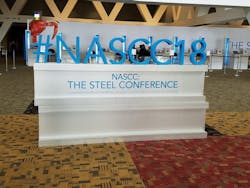Steel and aluminum tariffs raise more questions than answers for domestic suppliers
Over the past 90 days, the price of steel that Dallas-based DFW Grating buys from domestic mills to fabricate bar and plate grating has nearly doubled. C. Scott Netherton, DFW Grating’s Vice President of Business Development, added that steel distributors are scaling back their inventories unless they are sure they have a buyer.
“We’re not happy with the current situation,” said Netherton, meaning the uncertainty surrounding tariffs imposed on steel and aluminum imports that have rattled the U.S. market, where prices on some products had been rising since late last year.
“What makes this more difficult is that there’s so much momentum as far as manufacturing is concerned, and no one wants to upset that,” said Edward Youdell, President and CEO of the Fabricators & Manufacturers Association (FMA), which represents 1,500 companies.
Youdell and Netherton were manning booths at last week’s Steel Conference in Baltimore, sponsored by the American Institute of Steel Construction (AISC) and attended by more than 5,000 people. Like many attendees, they were trying to sort out the ramifications and consequences of the recent 25% tariffs on steel imports and 10% tariffs on aluminum imports imposed by the Trump Administration on March 23. “Anyone who says they’ve got this figured out is BSing you,” said Youdell.
He fears, though, that small fabricators will struggle to compete in this new competitive environment. “What our members would have preferred is no tariffs, let us have access to cheaper parts, and we could compete globally.”
Underutilized domestic mills could get a boost
Imports accounted for an estimated 27% of the 139 million tons of steel consumed in the U.S. in 2017. A year-long investigation by the U.S. Department of Commerce found sufficient evidence of unfair trade practices by foreign suppliers—notably China—to warrant tariffs to protect the American steel industry under the pretext of national security.
However, it didn’t take long for the administration to exempt several countries—including the European Union, Australia, South Korea, Mexico, Canada, Brazil, and Argentina—that by some estimates account for more than three fifths of all imports coming into the United States. Steel and aluminum suppliers are now scrambling to get specific products excluded from the tariffs.
There have been 1,200 applications for waivers from steel tariffs and 125 requests for exemptions from aluminum tariffs, numbers the Commerce Department confirmed to the Washington Post last Friday. “A tsunami is coming,” Kevin Dempsey, general counsel at the American Iron and Steel Institute, told the Post. “I anticipate there will be several thousand exclusion requests filed.”
Just how much protection the U.S. industry needs from imports, though, is a matter of debate. The top five U.S. steel producers—Nucor, U.S. Steel, Steel Dynamics, AK Steel, and Commercial Metals—all reported positive earnings in 2017 (although some were coming off of years when they lost money). Steel Dynamics alone reported record net income, $813 million, a 113% increase over earnings in fiscal 2016. (SDI did not return BD+C’s request for comment.)
It goes without saying, though, that tariffs could be a boon to underutilized American mills. AISC contends that U.S. steel manufacturers would have excess production capacity even in the unlikely event that they had to replace 100% of imports. (For example, domestic mills, with 10 million tons of structural steel capacity, produced 6.3 million tons last year, with another 1.7 million tons imported.)
“With domestic prices rising even before the tariffs went into effect, it’s been a challenge to buy, and it’s forced fabricators to align closer with suppliers and mills,” said Adam Zakeski, Vice President of Sales-decks and joists for Canam Group, an Allentown, Pa.-based producer and fabricator.
The impact of price hikes debated
Zakeski, Youdell, and Netherton expect prices to stabilize by the third quarter of this year. “Domestic mills can only push prices up so far,” said Zakeski, whose company is buying conservatively at the moment. But he’s skeptical of any rationalizations that “trivialize” the impact of price inflation on the industry’s competitiveness.
Steel and aluminum tariffs were a hot topic of discussion at last week's Steel Conference. Image: BD+C
In a recent webinar, Brian Raff and Tabitha Stine, AISC’s Director of Government Relations and Vice President, respectively, stated that the structural steel package on a $100 million project accounts for about $12 million, of which 30% is for materials from the mill or distributor. So, a worst-case 25% increase in materials costs would equal around $900,000, or less than 1% of the total project cost.
Raff and Stine were quick to note that a 25% tariff doesn’t typically translate to a 25% price increase. And, they said, until recently mill prices had been relatively stable over the past several years, hovering, with some ups and downs, at around $800 per ton.
While it remained uncertain last week exactly which products would ultimately fall under the tariffs, AISC is pushing hard to have fabricated structural steel imports included. “What we’ve been trying to show is that the tariff on mill steel only is subject to circumvention” by countries that could route their steel to companies in other countries that are exempted from the tariff, explained David Zalesne, President of Owens Steel Company in Columbia, S.C.
Zalesne thinks the tariffs are likely to have less impact, positive or negative, than Trump or his critics believe they will. But what happens next is anybody’s guess. The U.S. has indicated that it might end country exemptions in early May. That could lead to a country-by-country quota system as a prelude to new trade negotiations, suggested Frank Swain with the law firm Faegre Baker Daniels, which represents AISC’s interests in Washington.
He and Zalesne also echoed AISC’s insistence that the U.S. should include a “Buy American” provision as part of any infrastructure spending legislation.
“Right now, it’s a poker game,” observed Youdell.

